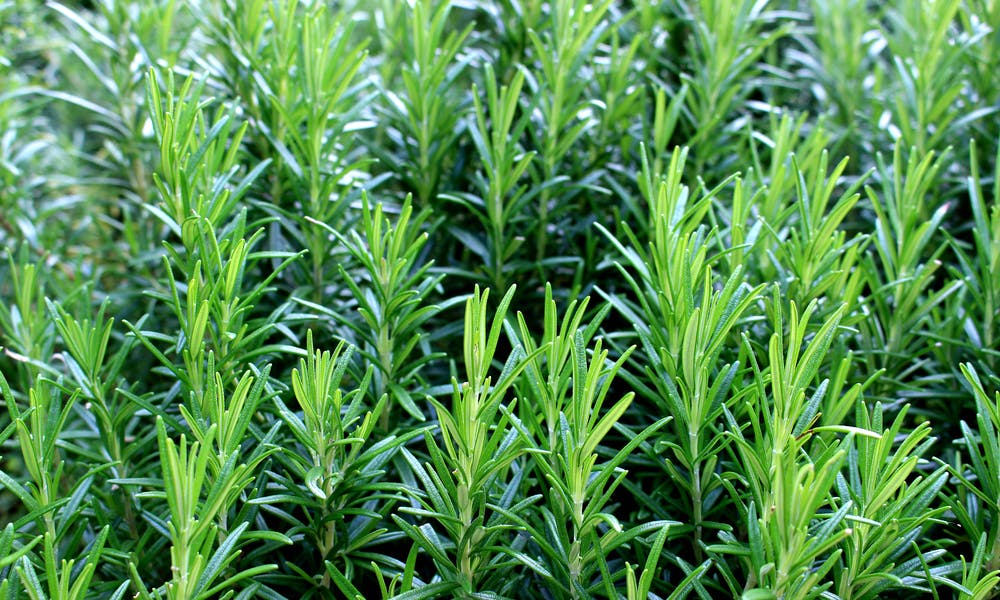MENU
Rosemary Plant: A Tasty Evergreen Herb

A native of the Mediterranean region, salvia rosmarinus, also known as rosemary, is an evergreen shrub, very aromatic, whose leaves are often used to add flavor to food. In addition to its cooking uses, rosemary’s herbaceous and energizing fragrance is often used for diffusing. In fact, this plant also has surprising medical uses. Read on to find out a little more about this flavorful plant:
* The history of the rosemary plant
* The origins of the rosemary plant
* Description of the rosemary plant
* How to plant and grow rosemary?
* How to consume rosemary?
* Uses of the rosemary plant
The History of The Rosemary Plant
First described around 5000 B.C. on cuneiform stone tables, it is understood that the Egyptians used the herb in their burial ceremonies because it has a fairly powerful scent. Later, there were more references to ancient Greeks and Romans, particularly “De Materia Medica,” one of the most important herbal writings in history.
Rosemary made its way to China during the late Han Dynasty around 220. In England, it is uncertain when rosemary was brought but most believe that it was the Romans who introduced the plant when they occupied the region in the 1st century.
For England, though, there are no official records until the 8th century. It is believed that Charlemagne brought it to the country, as he encouraged the monastic gardens and farms to grow rosemary and other herbs.
The Origins of The Rosemary Plant
The plant is known as one of the many hundred plants in the Salvia genus. It was classified in the beginning into a much smaller group, rosmarinus, that only included two or four members. Interestingly, the herb is also a part of the mint family, known under the name of “Labiatae.”
The name of rosmarinus comes from Latin, meaning “water dew,” as stated in “Flora Domestica” by Elizabeth Kent, suggesting that the rosemary thrives well by the sea. Rosemary frequently is a reference to fidelity, loyalty, remembrance, or sending the message of “your existence revives me,” depending on mythology and culture, associating different meanings and characteristics to these plants.
Description of The Rosemary Plant
The rosemary plant can reach a height of up to 6 feet, and this can be done over many years. Some plants live for decades. Its flowers range in color from white to dark purple or deep blue, with half an inch in length and two lobes on the upper lip and three lobes on the lower lip, including four stamens.
They are oily and somewhat coarse when it comes to the stems, needle-like with a conspicuous vein down in the middle, light green to nearly black on top and white or gray underneath the leaf.
The leaves’ composition is resinous and leathery, and dimensions vary from 1/3 inch to 1 1/2 inches.
Seeds are very thin, spherical nutlets with smooth surfaces and the stems are woody, straight and branching, somewhat square-shaped and coated with scaly bark.
How to Plant and Grow Rosemary?
Turning one rosemary plant into 100s is quite simple because it does not have any special needs. They are maintenance-free. It does not need much space and does not even need fertilizer. Rosemary loves sunlight, ideally, six to eight hours of sun per day and watering is needed only when the soil becomes really dry.
It can be grown either in a greenhouse or in containers as long as they have drainage holes and the soil does not retain water. You can use all-purpose fertilizer or manure to obtain the best soil for planting your rosemary before inserting the seeds.
While they need to be watered only when the soil becomes dry, it is important not to let it dry to the extent where the leaves start withering. Simply stick your finger 1 inch into the soil to check moisture levels and do not water the plant if it feels humid. Use pruning and pinching to encourage growth and branching.
How to Consume Rosemary?
From a culinary point of view, dried as well as fresh rosemary leaves can be used for food preparation. The incomparable fragrance would remain the same. Its flavor is spicy and warm, tonic and somewhat bitter, and its resinous scent makes it simple to recognize. It is often combined with rich meats such as beef, all sorts of oven-baked foods, sour lemons, and even sweet dishes and desserts. The trick to using rosemary is to finely cut it because otherwise, the needles are quite pointy and they need to be removed from the dish for safety reasons. Rinse the rosemary with cold water, cut the rosemary into individual sprigs, remove the needles, dice them, and sprinkle them on your dish.
Uses of the Evergreen Herb
In addition to culinary purposes, rosemary is also used for vinegar and oils, beverage infusions, home decoration, or even pest deterrent. Nevertheless, it has amazing effects on the human body as eating rosemary has many advantages, such as digestive aid, pain cure, calming stress and anxiety, enhances memory, and even natural deodorant if you use it regularly.
More specifically, the oil extracted from the leaf is used to treat a wide range of ailments. It helps with digestion, liver problems, cough, high blood pressure, headache, low blood pressure.
Furthermore, this magical plant is also used to treat psychological conditions, such as depression and stress, or even improving adults’ memory. Other uses of the rosemary plant include treating drug withdrawal symptoms, boosting energy levels and treating diabetic kidney diseases.
Lastly, rosemary is used topically to even treat baldness – it is believed that it enhances blood circulation that, in turn, prevents and treats hair loss.

